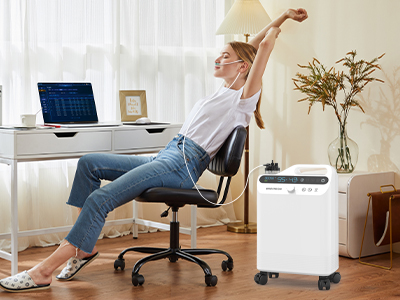29 Mar 2024
Oxygen concentrators have revolutionized the treatment of respiratory conditions, providing a convenient and efficient method for delivering supplemental oxygen to patients in need. However, despite their numerous advantages, it's crucial to consider the potential disadvantages associated with their use.

Dependence on Electricity
Oxygen concentrators operate by drawing in ambient air, filtering out nitrogen, and delivering concentrated oxygen to the user through a nasal cannula or mask. One significant disadvantage of these devices is their dependence on an electrical power source. Unlike portable oxygen tanks, which provide freedom of movement, oxygen concentrators require a constant supply of electricity to function effectively. This reliance on electrical power introduces the risk of power outages and interruptions, which can disrupt oxygen therapy and pose a safety concern for patients, particularly during emergencies or natural disasters.
Mobility Limitations
While portable oxygen concentrators offer some degree of mobility, they still come with limitations compared to portable oxygen tanks. The need for an electrical outlet to power the device restricts mobility, making it challenging for patients to engage in outdoor activities or travel freely. Unlike oxygen tanks, which can be easily transported and used in various settings, oxygen concentrators may limit patients' ability to maintain an active lifestyle and participate in social events or recreational activities outside the home.
Noise and Vibration
Another disadvantage of oxygen concentrators is the noise and vibration they produce during operation. While modern models are designed to minimize noise levels, they still emit sound that can be bothersome, especially in quiet environments such as bedrooms. Additionally, the vibration associated with the device's mechanical components can be disruptive, affecting sleep quality and daily activities. Patients may find it challenging to rest comfortably or concentrate on tasks while using an oxygen concentrator, leading to frustration and discomfort.

Maintenance Requirements
Maintaining an oxygen concentrator involves regular cleaning, filter replacement, and technical maintenance to ensure optimal performance and safety. While manufacturers provide guidelines for maintenance procedures, patients must dedicate time and effort to follow these instructions diligently. Failure to maintain the device properly can lead to malfunctions, decreased oxygen output, and potential health risks for the user. Additionally, the cost of replacement filters and technical servicing can add up over time, posing financial challenges for patients, especially those with limited resources.
Oxygen Purity and Flow Limitations
Oxygen concentrators vary in their ability to deliver oxygen at precise purity levels and flow rates. While most devices can achieve adequate oxygen purity for therapeutic use, there may be fluctuations in oxygen concentration, particularly at higher flow settings. Patients who require higher oxygen flow rates may experience limitations in the availability of suitable oxygen concentrator models or may need to use supplemental oxygen tanks as an alternative solution. Furthermore, variations in oxygen purity and flow rates can impact the effectiveness of oxygen therapy, potentially compromising patient outcomes.
Initial Cost and Insurance Coverage
One of the primary barriers to accessing oxygen concentrators is the high initial cost of purchasing the device. Unlike portable oxygen tanks, which are typically provided on a rental basis, oxygen concentrators require a significant upfront investment. Furthermore, insurance coverage for oxygen concentrators may be limited, and patients may encounter challenges in obtaining approval for reimbursement from insurance providers. The financial burden associated with purchasing an oxygen concentrator can pose challenges for patients, particularly those with limited financial resources or inadequate insurance coverage.
Psychological and Social Factors
In addition to the practical considerations, there are psychological and social factors that patients must contend with when using oxygen concentrators. The visible presence of medical equipment can contribute to feelings of self-consciousness and stigma, leading to decreased self-esteem and social withdrawal. Patients may also experience psychological distress related to their reliance on oxygen therapy, including anxiety about their health condition and uncertainty about the future. Adjusting to the lifestyle changes associated with oxygen therapy can be challenging, requiring patients to seek support from healthcare providers, family members, and support groups to cope effectively.
In conclusion, while oxygen concentrators offer significant benefits in the management of respiratory conditions, it's essential to recognize and address the potential disadvantages associated with their use. By understanding these drawbacks and implementing strategies to mitigate them, patients and healthcare providers can ensure that oxygen therapy remains safe, effective, and conducive to patients' overall well-being.
Keywords: oxygen concentrator
Originally published 29 Mar 2024, updated 29 Mar 2024.